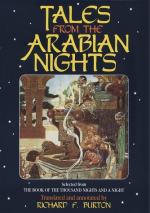[FN#331] This passage may have suggested to Walter Scott one of his descriptions in “The Monastery.”
[FN#332] In the text “Lajawardi,” for which see vols. iii. 33, and ix. 190.
[FN#333] In Galland and the H. V. “Prince Husayn’s.”
[FN#334] This is the “Gandharba-lagana” (fairy wedding) of the Hindus; a marriage which lacked only the normal ceremonies. For the Gandharbas = heavenly choristers see Moor’s “Hindu Pantheon,” p. 237, etc.
[FN#335] “Perfumed with amber” (-gris?) says Galland.
[FN#336] The Hind term for the royal levee, as “Selam” is the Persian.
[FN#337] Arab. “’Ilm al-Ghayb” = the Science of Hidden Things which, says the Hadis, belongeth only to the Lord. Yet amongst Moslems, as with other faiths, the instinctive longing to pry into the Future has produced a host of pseudo-sciences, Geomancy, Astrology, Prophecy and others which serve only to prove that such knowledge, in the present condition of human nature, is absolutely unattainable.
[FN#338] In folk-lore and fairy tales the youngest son of mostly three brothers is generally Fortune’s favourite: at times also he is the fool or the unlucky one of the family, Cinderella being his counterpart (Mr. Clouston, i. 321).
[FN#339] The parasang (Gr. {Greek}), which Ibn Khall. (iii. 315) reduces to three miles, has been derived wildly enough from Fars or Pars (Persia proper) sang = (mile) stone. Chardin supports the etymology, “because leagues are marked out with great tall stones in the East as well as the West, e.g., ad primam (vel secundam) lapidem.”
[FN#340] A huge marquee or pavilion-tent in India.
[FN#341] The Jinn feminine; see vol. i. 10. The word hardly corresponds with the Pers. “Peri” and Engl. “Fairy,” a creation, like the “Div,” of the so-called “Aryan,” not “Semitic,” race.
[FN#342] Galland makes the Fairy most unjustifiably fear that her husband is meditating the murder of his father; and the Hindi in this point has much the advantage of the Frenchman.
[FN#343] Pers. = “Light of the World”; familiar to Europe as the name of the Grand Moghul Jehangir’s principal wife.
[FN#344] The Arab stirrup, like that of the Argentine Gaucho, was originally made of wood, liable to break, and forming a frail support for lancer and sworder. A famous chief and warrior, Abu Sa’id al-Muhallab (ob. A. H. 83 = 702) first gave orders to forge foot-rests of iron.
[FN#345] For this Egyptian and Syrian weapon see vol. i. 234.
[FN#346] See vol. vii. 93, where an error of punctuation confounds it with Kerbela,—a desert with a place of pilgrimage. “Samawah” in Ibn Khall. (vol. i. 108) is also the name of a town on the Euphrates.




